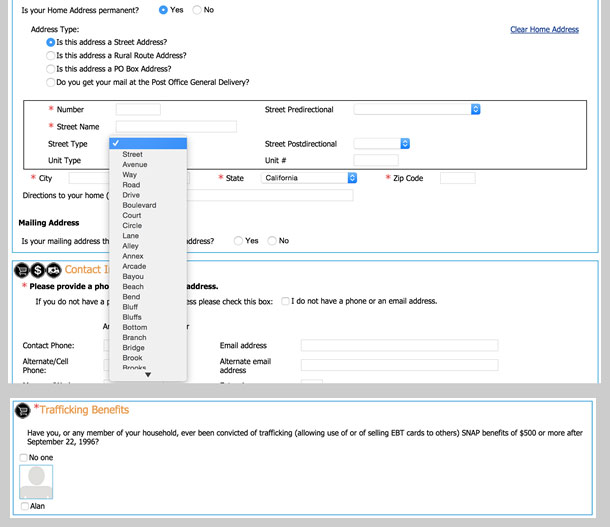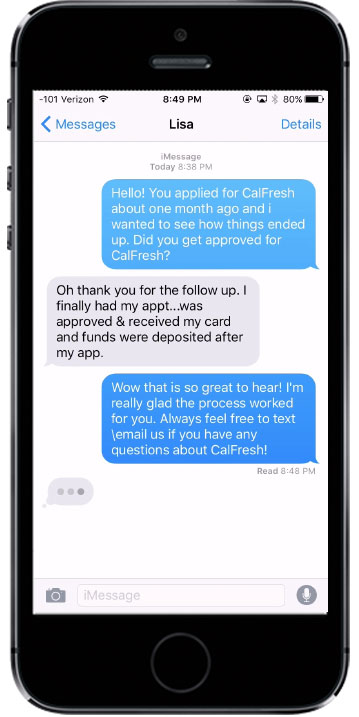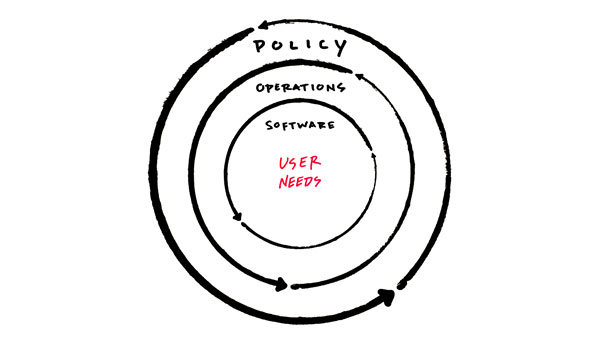Since 2011, Code for America (CfA) has worked with state and local governments to help realize the promise of our networked era—a 21st century public sector that delivers effective, efficient, and dignified services to the American people.
Code for America’s work is part of the broader civic technology movement—pioneered by the Government Digital Service in the United Kingdom and accelerated in the United States with the rescue of Healthcare.gov as well as the newly created United States Digital Service and 18F agencies. This movement, which is growing in state and local governments around the world, goes far beyond building better websites. It’s about transforming government to work in the 21st century—delivering public services that are both digital by default and continually evolving to meet user needs.
We have a long way to go, especially when it comes to America’s social safety net. Programs like Medicaid, Supplemental Security Income, and unemployment all fail to reach huge swaths of people eligible for these crucial benefits. In California, 40% of residents who qualify for Food Stamps aren’t getting them. That’s two million people in a single state.

Over the past year, Code for America has worked with Human Services agencies in California to improve access to CalFresh, the statewide Food Stamps program. While still early in the project, the work has evolved through three distinct phases. We began by documenting the “client journey,” including the user experience of existing online applications. Soon after we began using a “lean” service delivery approach to offer GetCalFresh.org, an easier way to apply online, relying heavily on customer support to discover and meet user needs. Now, as our research extends to both clients and government workers, we’ve begun building the feedback loops necessary to continue to meet user needs in a variety of ways including software, business processes, and policy.
Documenting Barriers in the Application Process
We didn’t have to travel far to observe the barriers clients face when trying to access services like CalFresh. CfA is headquartered in San Francisco’s SOMA neighborhood, around the corner from the main lobby of the Human Services Agency (HSA) where residents enroll in CalFresh and other social services. Wait times at the HSA are generally long and the wait is rarely comfortable.
In 2013, Jacob Solomon of CfA took a page from Samuel Hulick of UserOnboard.com and documented the entire online application (known as MyBenefitsCalWIN.org), annotating screenshot after screenshot with his reactions as he completed the 100-question, 30-page long web form.
Jake repackaged the online application and presented it to policymakers as a slide deck, making it far easier to experience the long and unwieldy process. It turns out that few policymakers—even those most committed to improving client experience—had ever had the opportunity to go through the entire application themselves. Jake’s “teardown” helped them witness firsthand what thousands of Californians experienced every day—an application that was very long, difficult to navigate, and thoroughly confusing.

The Code for America team also interviewed real applicants about their experience using MyBenefitsCalWIN. Deploying our own URL, we acquired visitors intent on applying for CalFresh by running Google Adwords and enabled those visitors to use MyBenefitsCalWIN on our own URL, embedding the site within an iframe. Before visitors began the application we used Ethn.io to solicit responses via a short screening survey and recruited them to participate in telephone interviews about their application experience once complete.
After more than 100 screener responses and 30 phone interviews, we learned that 40% of people who started a MyBenefitsCalWIN application never completed it. Among those who did finish, it took them on average almost 30 minutes to complete. Most people did not know the next steps in the process—of which there were many.
Giving policymakers tools to understand the status quo gave CfA the credibility to try a different approach to delivering CalFresh. With the help of HSA leadership, frontline workers, and the local food security community, the CfA team developed an alternative online application that was quick to complete, easy to navigate, written in plain language, and designed for use on mobile phones. In 2014 we submitted our first legally valid application for Food Stamps through a prototype of GetCalFresh.org (it just faxed a PDF to the HSA office). Soon after, we had the blessing to go help real people submit real applications for Food Stamps in San Francisco.
Supporting People throughout the Client Journey
Of course, just a handful of users can reveal a whole world of needs. We started offering customer support via e-mail and SMS early on and heard from users immediately. We quickly learned that submitting a CalFresh application is really just the beginning; clients need to have an interview with county staff and provide documentation of their personal finances. It’s a long process—taking up to 30 days—defined by complex rules and unreliable communication between people and the government.

By offering meaningful customer support through this process, we not only learned official program rules, but also the nuances of government operations that clients must navigate to successfully enroll. As a result we were able to set better expectations about what lay ahead for each client that applied through GetCalFresh.org. We began asking clients to opt-in to reminders and follow-ups sent by text and email using off-the-shelf services like Textit.in and Intercom. Using confirmation messages, we reiterate that an interview is the critical next step and link to relevant phone numbers. A few days later we remind folks that if they have not yet had their interview they should take action immediately. Another week later we remind them to submit key documents and give them the means to do so. After thirty days, we ask clients whether or not they were successfully approved.

Each of these follow-up messages is an opportunity for clients to start a conversation with us and get help. This continues to be one of the best ways for our team to learn about the variety and nuance of the client experience. In turn, each customer support interaction is an opportunity for us to recruit clients for more in-depth user interviews. A generous donation from Amazon.com has enabled us to offer gift codes as an incentive to participate in further interviews, which has proved both popular and easy to distribute via SMS and e-mail.
Through client interviews (and now live chat support), the CfA team continues to uncover needs that users have throughout the enrollment process. However, our research interviews also require being prepared to serve the client’s immediate well-being. After all, people that are applying for benefits online have often recently experienced some trauma—whether it be job loss, injury, divorce, or countless other challenges that life presents. As a result, the interviews are a balance between encouraging people to tell their story and respecting their privacy. It requires significant emotional presence and often ends by connecting people with health and food security resources in their community that can help them get through a time of acute need. When delivering social services there is a constant balance to be struck between doing the work to build a scalable product and the work to help each individual get the help as quickly and easily as possible.
Improving the Way Agencies Do Business
Customer support and continuous user research has helped us in a number of ways. It’s helped us prioritize enhancements to GetCalFresh.org—like easier document submission and a way to estimate eligibility earlier on in the process. It’s also helped us discover other interactions that are particularly burdensome for clients but don’t actually help government staff do their work well.
In one partner county we learned applications for some clients were being flagged as incomplete and a paper application (with its dozens of questions, written in terse jargon) was then being mailed for them to fill out and return. This follow-up added a week or more to the application process, introduced a significant opportunity for things to go wrong, and left the client in limbo. The pattern came into view through a series of interviews, giving us the anecdotal information we needed to know the right questions to ask of our partners inside government. Ultimately, we were able to make changes to both GetCalFresh.org and the county business process to ensure nobody applying online would be mailed a paper application. Now we’re beginning to travel a similar feedback loop with patterns we’ve observed with the semi-annual recertifications clients must complete to stay in the program.

At Code for America, we think that this is how we begin to realize the promise of 21st Century government. User-centered software can help governments deliver services that anticipate messy logistics and work for people in the context of their daily lives. Since we started our work there have been many improvements to the process, for example:
- org now enables Californians to apply for Food Stamps in about 12 minutes, and they are approved at rates comparable to other channels.
- About one third of applicants apply from their mobile phones; key documents can be photographed and submitted with just a few taps.
- Chat support from a human is available for anyone who needs it.
- Measuring the behavior of users and continually conducting research creates tight feedback loops about user experience that the public servants working to deliver services have never previously enjoyed. For the first time, software applications can help inform enhancements to government operations, user need by user need.
Code for America’s work with California counties delivering Food Stamps is ultimately still just a pilot. However, the tactics and practices that have helped us design GetCalFresh.org are useful to anyone working to improve a public sector program or service, whether they are government staff or consultants. The cost and complexity of delivering real services has fallen enough that in 2015 and beyond, UX designers, researchers, and hackers have the power to start serving real users inside even in the most complicated legacy institutions.
